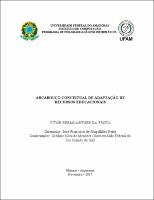| ???jsp.display-item.social.title??? |


|
Please use this identifier to cite or link to this item:
https://tede.ufam.edu.br/handle/tede/6216| ???metadata.dc.type???: | Tese |
| Title: | Arcabouço conceitual de adaptação de recursos educacionais |
| ???metadata.dc.creator???: | Frota, Vitor Bremgartner da  |
| ???metadata.dc.contributor.advisor1???: | Magalhães Netto, José Francisco de |
| First advisor-co: | Menezes, Crediné Silva de |
| ???metadata.dc.contributor.referee1???: | Castro Junior, Alberto Nogueira de |
| ???metadata.dc.contributor.referee2???: | Pio, José Luiz de Souza |
| ???metadata.dc.contributor.referee3???: | Tavares, Orivaldo de Lira |
| ???metadata.dc.contributor.referee4???: | Cavalcanti, João Marcos Bastos |
| ???metadata.dc.description.resumo???: | Normalmente, os recursos existentes em Ambientes Virtuais de Aprendizagem (AVAs), utilizados em cursos de Educação a Distância (EaD) e em semipresenciais, são apresentados da mesma forma para todos os alunos. Isto pode não ser útil para a aprendizagem efetiva de cada aluno. A abordagem adotada para solução deste problema nesta tese baseia-se em um framework chamado ArCARE (Arcabouço Conceitual de Adaptação de Recursos Educacionais), sendo uma estratégia que permite a criação de Smart Learning Environments (SLEs) e adaptação de recursos para alunos em AVAs no decorrer do curso, com base no Construtivismo de Piaget, utilizando a tecnologia de sistema multiagente que manipula uma ontologia de modelo aberto de aluno composto de várias características do aluno de acordo com suas interações com o AVA e seu engajamento no curso, tais como competências, habilidades, desempenho nas atividades, frequência, preferências e estilos de aprendizagem. Estes recursos adaptados no AVA podem ser desde uma recomendação de colegas para ajudar alunos com dificuldades em atividades, como também a recomendação de propostas de atividades colaborativas com o objetivo de o aluno ter uma aprendizagem mais efetiva do conteúdo de um determinado curso. A solução descrita nesta tese também se baseia na aprendizagem colaborativa pela interação entre aprendizes, na qual é um método empregado com o propósito de construir seu conhecimento de maneira mais significativa em um AVA. Além disso, o modelo de cada aluno é alterado dinamicamente durante o curso, por meio das interações do aluno com o AVA. Este modelo é apresentado para o aluno, utilizando-se Learning Analytics (LA), com o objetivo do aluno conhecer seu estado atual no curso, permitindo uma aprendizagem auto-regulada. Um dos resultados gerados no ArCARE foi o sistema AMPARA (do inglês, Adaptive Multi-agent Pedagogical Architectures for Resources and Activities in VLEs, que em português fica Arquiteturas Pedagógicas Multiagente Adaptativas para Recursos e Atividades em AVAs), aplicado em disciplinas com currículos tradicionais como Cálculo Numérico e Algotimos e Programação, na modalidade semipresencial para recomendar APs. Outro resultado foi o sistema AMPARAX (eXtended AMPARA), que foi aplicado em um curso com currículo flexível, de Pensamento Computacional para Programação de Computadores no AVA Moodle, mostrando, assim, as provas de conceito do ArCARE. |
| Abstract: | Usually, the resources available in Virtual Learning Environments (VLEs), used in distance and blended courses, are presented in the same way for all students. This may not be useful for the effective learning of each student. The approach adopted to solve this problem in this thesis is based on a framework called ArCARE (Conceptual Framework of Adaptation of Educational Resources), being a strategy that allows the development of Smart Learning Environments (SLEs) and adaptation of resources to students in VLEs during the course, based on the Piaget Constructivism, using multi-agent system technology that manipulates an open learner model ontology composed of several characteristics of the student according to their interactions with the VLE and their engagement in the course such as competences, skills, performance in activities, frequency, preferences, and learning styles. These adapted resources in the VLE can be a recommendation of colleagues to help students with difficulties in activities, as well as the recommendation of proposed collaborative activities with the aim of the student to have a more effective learning of the course contents. The solution described in this thesis is also based on collaborative learning by the interaction between learners, in which it is a method used for the purpose of construct his knowledge in a more meaningful way in VLEs. In addition, each learner model is changed dinamically during the course, through the student's interactions with the VLE. This model is presented to the student using Learning Analytics (LA), with the objective of the student to know their current state in the course, allowing a self-regulated learning. One of the results generated in ArCARE was the AMPARA system (Adaptive Multi-agent Pedagogical Architectures for Resources and Activities in VLEs), applied in disciplines with traditional curricula such as Numerical Calculus and Algorithms and Programming in the blended mode in order to recommend PAs. Another result was the AMPARAX system (eXtended AMPARA), which was applied in a course with flexible curriculum, Computational Thinking for Computer Programming using Moodle VLE, showing, therefore, ArCARE's proofs of concept. |
| Keywords: | Ambientes Virtuais de Aprendizagem Adaptação de recursos Agentes de software Modelo aberto de aluno Smart Learning Environments |
| ???metadata.dc.subject.cnpq???: | CIÊNCIAS EXATAS E DA TERRA: CIÊNCIA DA COMPUTAÇÃO |
| Language: | por |
| ???metadata.dc.publisher.country???: | Brasil |
| Publisher: | Universidade Federal do Amazonas |
| ???metadata.dc.publisher.initials???: | UFAM |
| ???metadata.dc.publisher.department???: | Instituto de Computação |
| ???metadata.dc.publisher.program???: | Programa de Pós-graduação em Informática |
| Citation: | FROTA, Vitor Bremgartner da. Arcabouço conceitual de adaptação de recursos educacionais. 2017. 217 f. Tese (Doutorado em Informática) - Universidade Federal do Amazonas, Manaus, 2017. |
| ???metadata.dc.rights???: | Acesso Aberto |
| ???metadata.dc.rights.uri???: | http://creativecommons.org/licenses/by-nc-nd/4.0/ |
| URI: | http://tede.ufam.edu.br/handle/tede/6216 |
| Issue Date: | 24-Nov-2017 |
| Appears in Collections: | Doutorado em Informática |
Files in This Item:
| File | Description | Size | Format | |
|---|---|---|---|---|
| Tese_Vitor B. Frota.pdf | 11.51 MB | Adobe PDF |  Download/Open Preview |
This item is licensed under a Creative Commons License





